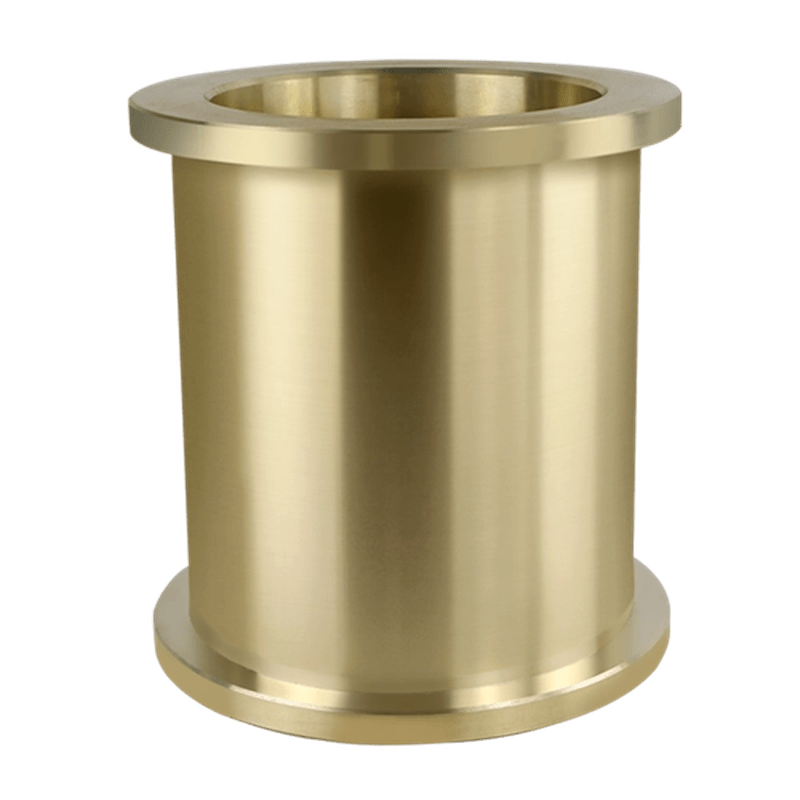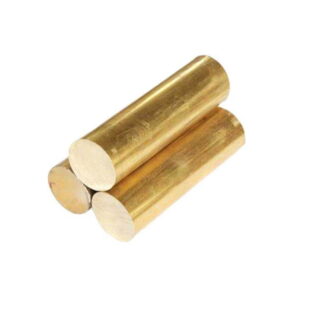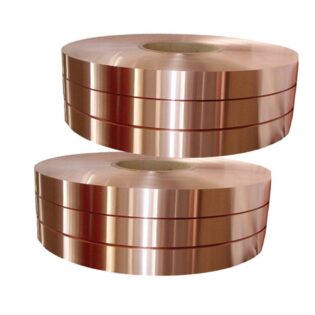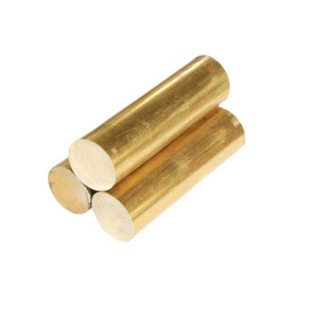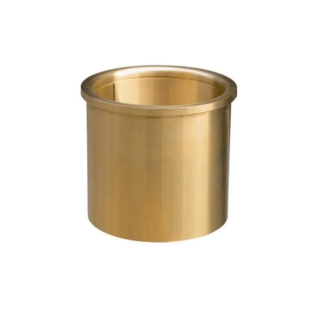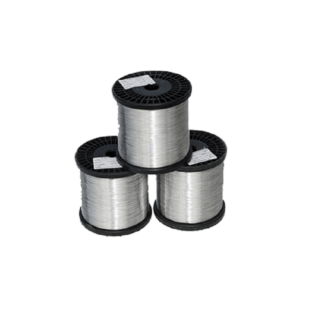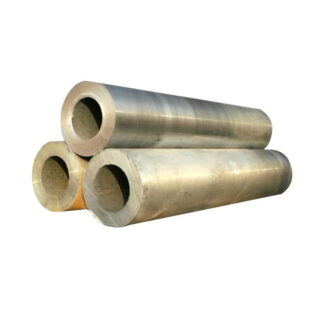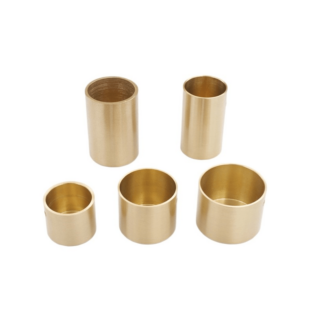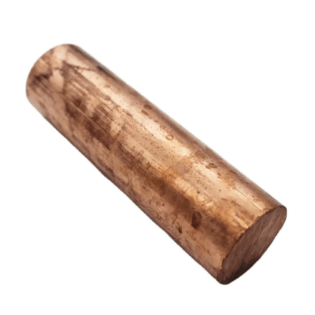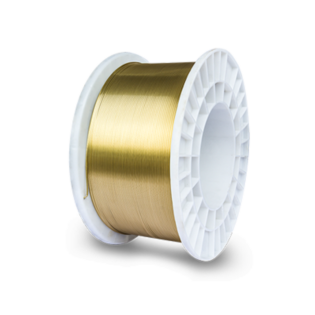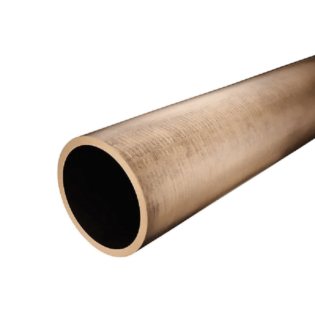AMS 4880-C95510 Nickel Aluminum Bronze Product Introduction
Composizione chimica
| Elemento | Percentuale (%) | Role in the Alloy |
|---|
| Insieme a | 78,00 minuti | Primary constituent, provides base structure and properties |
| Sn | 0.20 massimo | Migliora la resistenza alla corrosione e la robustezza |
| Zn | 0.30 massimo | Enhances strength and acts as a deoxidizer |
| Fe | 2.00-3.50 | Refines grain structure and increases strength |
| Ni | 4.50-5.50 | Improves corrosion resistance and mechanical properties |
| Al | 9.70-10.90 | Forms intermetallic compounds, enhancing strength and wear resistance |
| mn | 1,50 massimo | Improves strength and deoxidizes the alloy |
Note: Cu + sum of named elements, 99.8% min. Ni value includes Co. Unless otherwise noted, single values represent maximums.
Proprietà meccaniche
| Proprietà | Castings <4.0, Heat Treated | Castings 4.0+, Heat Treated |
|---|
| Resistenza alla trazione, min | 105.0 ksi (724 MPa) | 95.0 ksi (655 MPa) |
| Yield strength (0.2% Offset), min | 62.5 ksi (431 MPa) | 56.0 ksi (386 MPa) |
| Elongation in 4D, min | 9% | 9% |
| Durezza Brinell | 192 to 248 BHN | 192 to 248 BHN |
Prestazioni a diverse temperature
| Intervallo di temperatura | Caratteristiche di performance |
|---|
| Low Temperatures (-50°C to 0°C) | Maintains good ductility and toughness |
| Room Temperature (20°C to 25°C) | Optimal balance of strength and ductility |
| Moderate Temperatures (100°C to 200°C) | Retains good hardness and wear resistance |
| Elevated Temperatures (200°C to 300°C) | Slight decrease in strength, but maintains good corrosion resistance |
| High Temperatures (300°C to 400°C) | Reduced mechanical properties, but still usable in some applications |
Applicazioni industriali
| Settore industriale | Applicazioni specifiche |
|---|
| Aerospaziale | Landing gear bushings, bearings in aircraft structures |
| Marino | Propellers, pump impellers, valve components in seawater systems |
| Olio e gas | Offshore platform components, subsea equipment |
| Rendimento della resistenza alla trazione | Bushings in suspension systems, gearbox components |
| Macchinari industriali | Wear plates, bushings in heavy machinery |
| Estrazione mineraria | Pump components, conveyor system parts |
| Produzione di energia | Turbine components, valve seats in power plants |
Disponibilità di forme e dimensioni
| Modulo | Gamma di dimensioni | è un acciaio strutturale ad alta resistenza a bassa lega standard cinese GB |
|---|
| Solidi | Da 1/2" a 9" D.E. | – |
| Tubi | 1 1/8″ to 13″ O.D. | Consult mill for wall thickness |
| Rettangoli | Fino a 15″ | – |
| Standard lengths | 24″ | Consult mill for other lengths |
| Bar Stock | Various diameters | Available in round, hexagonal, and square shapes |
| Piatto | Fino a 6″ di spessore | Width and length vary by thickness |
| forgiati | Dimensioni personalizzate | Made to order based on specifications |
Standard di produzione
| Standard | Descrizione |
|---|
| AMS 4880 | Aerospace Material Specification for Nickel Aluminum Bronze |
| ASTM B150 | Specifiche standard per aste, barre e forme in bronzo-alluminio |
| ASTM B171 | Standard Specification for Copper-Alloy Plate and Sheet for Pressure Vessels, Condensers, and Heat Exchangers |
| SAE J461 | Wrought Copper and Copper Alloy Heat Exchanger Tube |
| MIL-B-21230 | Military Specification for Bronze, Aluminum |
Standards and Corresponding Grades in Different Countries
| Paese/regione | Standard/Grado | Equivalent Designation |
|---|
| Stati Uniti d'America | AMS 4880-C95510 | UNS C95510 |
| Europa | EN 1982-CC333G | CuAl10Ni5Fe4 |
| Giappone | JIS H5120-CAC703 | – |
| Cina | GB/T 5231-QAl9-4 | – |
| Russia | GOST 493-79 Grade BrA9Zh4N4 | – |
| India | IS 3091 Grade 2 | – |
| Australia | AS 2074-CA953 | – |
Welding, Processing, Polishing, Heat Treatment, Cold Processing
Saldatura
| Metodo di saldatura | adeguatezza | è un acciaio strutturale ad alta resistenza a bassa lega standard cinese GB |
|---|
| Gas Tungsten Arc Welding (GTAW/TIG) | Eccellente | Preferred method for high-quality welds |
| Gas Metal Arc Welding (GMAW/MIG) | Bene | Suitable for larger components |
| Shielded Metal Arc Welding (SMAW) | Equo | Can be used but not preferred |
| Electron Beam Welding | Eccellente | For precision welding in aerospace applications |
| Friction Stir Welding | Bene | Emerging method for solid-state joining |
in lavorazione
| Metodo di elaborazione | Valutazione di lavorabilità | è un acciaio strutturale ad alta resistenza a bassa lega standard cinese GB |
|---|
| girando | 50 (0-100 scale) | Use carbide tools for best results |
| Fresatura | 50 (0-100 scale) | Moderate cutting speeds recommended |
| foratura | 50 (0-100 scale) | Use high-speed steel or carbide drills |
| Rettifica | Bene | Suitable for achieving tight tolerances |
| Electrical Discharge Machining (EDM) | Eccellente | For complex shapes and profiles |
Lucidatura
| Metodo di lucidatura | Fine raggiungibile | è un acciaio strutturale ad alta resistenza a bassa lega standard cinese GB |
|---|
| Lucidatura meccanica | Finitura a specchio | Utilizzare abrasivi progressivamente più fini |
| Elettrolucidatura | Alta lucentezza | Adatto per geometrie complesse |
| Lucidatura | Alta brillantezza | Passaggio finale per applicazioni decorative |
Trattamento termico
| Processo di trattamento termico | Intervallo di temperatura | Scopo |
|---|
| Ricottura della soluzione | 870-900°C | Omogeneizzare la microstruttura |
| tempra | Raffreddamento rapido a temperatura ambiente | Aumenta la forza e la durezza |
| Invecchiamento | 350-400°C per 2-4 ore | Migliorare le proprietà meccaniche |
| Alleviare lo stress | 350-400°C per 1-2 ore | Ridurre le tensioni interne |
Lavorazione a freddo
| Metodo di lavorazione a freddo | Effetto sul materiale | Applicazioni |
|---|
| Laminazione a freddo | Aumenta la forza e la durezza | Produzione di lastre e nastri |
| Trafilatura a freddo | Migliora la finitura superficiale e la precisione dimensionale | Produzione di fili e tubi |
| Forgiatura a freddo | Migliora le proprietà meccaniche | Componenti di forma quasi netta |
Vantaggi e svantaggi dei materiali
Vantaggi
| Vantaggio | Descrizione |
|---|
| Molta forza | Eccellente resistenza alla trazione e allo snervamento rispetto a molte altre leghe di rame |
| Resistenza all'usura | Resistenza superiore all'abrasione e al grippaggio |
| Resistenza alla corrosione | Buona resistenza all'acqua di mare e a molti prodotti chimici |
| Conduttività termica | Better than stainless steels, suitable for heat exchange applications |
| Antiscintilla | Sicuro per l'uso in ambienti esplosivi |
| Low Magnetic Permeability | Suitable for applications requiring non-magnetic materials |
Svantaggi
| Svantaggio | Descrizione |
|---|
| Costo | More expensive than simpler copper alloys or steels |
| Il peso | Heavier than aluminum alloys, which may be a concern in some applications |
| Complex Processing | Requires careful control during casting and heat treatment |
| Limited Ductility | Less ductile than pure copper or some other copper alloys |
| Potential for Stress Corrosion Cracking | Can occur under certain environmental conditions |
Prodotti simili e confronto
Similar Nickel Aluminum Bronze Alloys
| Designazione della lega | Composizione chimica | Differenze chiave |
|---|
| C95800 | Cu-9Al-4Fe-4Ni | Higher iron content, slightly lower strength |
| C95700 | Cu-11Al-3Fe-5Ni | Higher aluminum content, increased hardness |
| C95400 | Cu-11Al-4Fe | No nickel, lower corrosion resistance |
Comparison with Other Material Classes
| Materiale | Advantages over C95510 | Disadvantages compared to C95510 |
|---|
| Stainless Steel 316 | Lower cost, higher availability | Lower thermal conductivity, higher weight |
| Aluminum Bronze (e.g., C95400) | Lower cost, easier to cast | Lower strength and corrosion resistance |
| Bronzo fosforoso | Better electrical conductivity | Lower strength and wear resistance |
| Titanium Alloys | Lower density, higher strength-to-weight ratio | Much higher cost, more difficult to machine |
Detailed Comparison Table
| Proprietà | AMS 4880-C95510 | Stainless Steel 316 | Aluminum Bronze C95400 | Titanio grado 5 (Ti-6Al-4V) |
|---|
| Resistenza alla trazione (MPa) | 655-724 | 515-690 | 586-758 | 895-930 |
| Carico di snervamento (MPa) | 386-431 | 205-310 | 241-379 | 828-910 |
| Allungamento (%) | 9 (min) | 40 | 12 | 10-15 |
| Densità (g/cm³) | 7.64 | 8.00 | 7.45 | 4.43 |
| Conducibilità termica (W/m·K) | 42 | 16.3 | 59 | 6.7 |
| Corrosion Resistance in Seawater | Eccellente | Eccellente | Bene | Eccellente |
| Machinability (0-100 scale) | 50 | 50 | 60 | 30 |
| Relative Cost | Alto | Moderare | Moderare | Molto alto |
Additional Properties and Characteristics
| Proprietà | Valore | Unità |
|---|
| Rendimento della resistenza alla trazione | 14.4 | µΩ·cm |
| Capacità termica specifica | 0.375 | J/g·°C |
| Rendimento della resistenza alla trazione | 1030-1060 | °C |
| Modulo di elasticità | 110-120 | GPa |
| Rapporto di Poisson | 0.33 | – |
| Fatigue Strength (10⁷ cycles) | 207-241 | MPa |
| Damping Capacity | Moderare | – |
Environmental and Recycling Considerations
| Aspetto | Descrizione |
|---|
| Riciclabilità | Highly recyclable, can be remelted and reused |
| Impatto ambientale | Lower energy requirement for recycling compared to primary production |
| Toxicity | Non-toxic in solid form, but dust and fumes during processing should be controlled |
| End-of-Life | Can be collected and recycled through established metal recycling streams |
Quality Control and Testing Methods
| Metodo di prova | Scopo | Standard |
|---|
| Prove di trazione | Determine strength and ductility | ASTM E8 |
| Test di durezza | Measure surface hardness | ASTM E10 (Brinell) |
| Analisi chimica | Verify composition | ASTM E478 |
| Test ad ultrasuoni | Rilevare i difetti interni | ASTM E114 |
| Test radiografici | Inspect for porosity and inclusions | ASTM E1742 |
| Corrosion Testing | Evaluate corrosion resistance | ASTM G31 |
Storage and Handling Recommendations
| Aspetto | Recommendation |
|---|
| Storage Environment | Dry, clean area away from chemicals |
| Handling | Use appropriate lifting equipment for heavy pieces |
| Protezione | Apply protective coatings or wraps to prevent surface damage |
| Inventory Management | Use FIFO (First In, First Out) system to manage stock |
| Safety Precautions | Wear appropriate PPE when handling, especially during cutting or machining |
Typical Lead Times and Pricing Factors
| Fattore | Descrizione |
|---|
| Standard Stock Sizes | Solitamente disponibile con tempi di consegna di 1-2 settimane |
| Dimensioni/forme personalizzate | Potrebbe richiedere un tempo di consegna di 4-8 settimane |
| Quantità | Gli ordini più grandi possono avere tempi di consegna più lunghi ma prezzi migliori |
| Condizioni di mercato | I prezzi del rame e del nichel possono influire in modo significativo sul costo finale |
| Requisiti di certificazione | Certificazioni speciali possono aumentare tempi e costi |
Conclusione
Il bronzo alluminio nichel AMS 4880-C95510 è una lega ad alte prestazioni che offre un'eccellente combinazione di robustezza, resistenza all'usura e resistenza alla corrosione. La sua versatilità lo rende adatto a un'ampia gamma di applicazioni in vari settori, in particolare in ambienti marini e aerospaziali. Sebbene possa avere un costo iniziale più elevato rispetto ad altri materiali, le sue prestazioni e la sua durata a lungo termine spesso si traducono in costi del ciclo di vita inferiori per i componenti critici. La capacità del materiale di mantenere le sue proprietà in diverse condizioni operative, unita alle sue caratteristiche antiscintilla, lo rendono la scelta preferita per applicazioni critiche per la sicurezza. Come per qualsiasi materiale specializzato, è necessario prestare la dovuta attenzione alla progettazione, alla lavorazione e alla manutenzione per sfruttare appieno le sue capacità e garantire prestazioni ottimali per tutta la sua durata di servizio.
